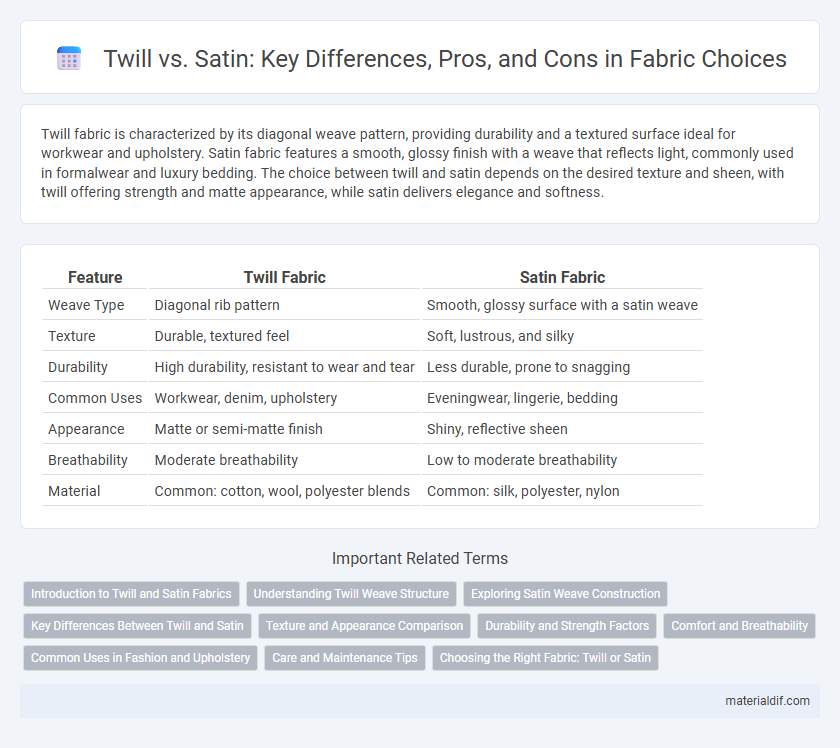Twill fabric is characterized by its diagonal weave pattern, providing durability and a textured surface ideal for workwear and upholstery. Satin fabric features a smooth, glossy finish with a weave that reflects light, commonly used in formalwear and luxury bedding. The choice between twill and satin depends on the desired texture and sheen, with twill offering strength and matte appearance, while satin delivers elegance and softness.
Table of Comparison
| Feature | Twill Fabric | Satin Fabric |
|---|---|---|
| Weave Type | Diagonal rib pattern | Smooth, glossy surface with a satin weave |
| Texture | Durable, textured feel | Soft, lustrous, and silky |
| Durability | High durability, resistant to wear and tear | Less durable, prone to snagging |
| Common Uses | Workwear, denim, upholstery | Eveningwear, lingerie, bedding |
| Appearance | Matte or semi-matte finish | Shiny, reflective sheen |
| Breathability | Moderate breathability | Low to moderate breathability |
| Material | Common: cotton, wool, polyester blends | Common: silk, polyester, nylon |
Introduction to Twill and Satin Fabrics
Twill fabric is characterized by its distinctive diagonal weave pattern, offering durability and resistance to wrinkles, commonly used in denim and upholstery. Satin fabric features a smooth, glossy surface created by a weaving technique that produces a high sheen on one side, often employed in evening wear and luxury bedding. Both fabrics differ in texture and appearance, influencing their suitability for various applications in fashion and interior design.
Understanding Twill Weave Structure
Twill weave features a distinctive diagonal rib pattern created by weaving the weft thread over one or more warp threads and then under two or more warp threads in a repeating sequence. This structure makes twill fabric more durable and resistant to wrinkles compared to satin, which has a smooth, glossy surface due to floating yarns. Understanding the twill weave structure helps in selecting fabrics for applications requiring strength, flexibility, and easy maintenance.
Exploring Satin Weave Construction
Satin weave construction creates a smooth, lustrous surface by floating warp yarns over multiple weft yarns, resulting in fewer interlacings and a glossy finish. This weaving technique enhances the fabric's sheen and drape, making satin ideal for luxury garments and upholstery. Compared to twill, which features diagonal ribs, satin's distinctive float structure maximizes light reflection and softness.
Key Differences Between Twill and Satin
Twill fabric is characterized by its diagonal weave pattern that creates a durable, textured surface, making it ideal for sturdy applications like denim and workwear. Satin fabric features a smooth, glossy surface achieved through a weaving technique that floats warp or weft yarns to emphasize luster, commonly used in evening wear and luxury bedding. The primary differences lie in texture and appearance--twill's rugged texture contrasts sharply with satin's sleek sheen--alongside their varying durability and usage.
Texture and Appearance Comparison
Twill fabric features a distinctive diagonal weave that creates a textured surface with visible ridges, providing durability and resistance to wrinkles. Satin fabric displays a smooth, glossy surface with a lustrous sheen, achieved through a weave that emphasizes floating yarns, offering an elegant and luxurious appearance. Twill's matte finish contrasts with satin's reflective shine, making each suitable for different aesthetic and tactile preferences in fashion and upholstery.
Durability and Strength Factors
Twill fabric features a distinctive diagonal weave pattern that enhances its durability and strength, making it resistant to tearing and wear over time. In contrast, satin weave, characterized by a smooth surface with fewer interlacings, tends to be more delicate and prone to snagging, reducing its overall strength. The tightly woven structure of twill provides better abrasion resistance, making it ideal for heavy-duty applications, whereas satin is favored for its sheen and softness rather than durability.
Comfort and Breathability
Twill fabric features a diagonal weave that enhances durability and allows air to flow more freely, making it comfortable and breathable for everyday wear. Satin, characterized by its smooth, glossy surface created through a weave that packs threads closely together, tends to trap heat and moisture, reducing breathability. Choosing twill over satin often results in better comfort, especially in warm or active conditions where airflow and moisture wicking are essential.
Common Uses in Fashion and Upholstery
Twill fabric, characterized by its diagonal weave, is commonly used in fashion for durable garments such as jeans, jackets, and workwear, providing strength and resistance to wear. Satin, with its smooth, glossy surface and luxurious drape, is favored in fashion for evening gowns, blouses, and lingerie, creating an elegant and sophisticated appearance. In upholstery, twill offers durability and ease of maintenance for everyday furniture, while satin is less common due to its delicate nature but is occasionally used for decorative cushions and accent pieces.
Care and Maintenance Tips
Twill fabric demands gentle washing in cold water to preserve its diagonal weave, with air drying preferred to avoid shrinkage and maintain texture. Satin requires extra care: hand washing or using a delicate machine cycle with mild detergent prevents damage to its smooth, glossy surface, while avoiding direct heat and ironing on low settings preserves its sheen. Proper storage in a cool, dry place minimizes fabric distortion and extends the lifespan of both twill and satin textiles.
Choosing the Right Fabric: Twill or Satin
Twill fabric offers durability and a distinctive diagonal weave, making it ideal for workwear and casual clothing requiring resilience. Satin provides a smooth, glossy surface with a luxurious feel, often chosen for evening wear and elegant garments where sheen and softness are priorities. When selecting between twill and satin, consider the fabric's intended use, desired texture, and maintenance needs to ensure the right balance of comfort, appearance, and function.
Twill vs Satin Infographic

 materialdif.com
materialdif.com